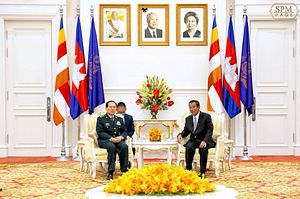Next month, China and Cambodia are expected to kick off the latest iteration of a bilateral military exercise between them. While some specifics remain unclear, the annualized drills will nonetheless be another demonstration of the growing significance of defense ties between the two countries amid wider domestic and regional dynamics.
As I have observed before in these pages, while Cambodia has long had a defense relationship with China – with Beijing being the Southeast Asian state’s largest donor of military aid – the security aspect of ties between the two countries has nonetheless come under intensified scrutiny over the past few years amid wider developments, including Cambodia’s tighter embrace of Beijing amid its deteriorating rights record and fears of Chinese military facilities in Cambodia.
One of these engagements has been Exercise Golden Dragon. Originally billed as focused on areas such as natural disaster relief and featuring just a few hundred personnel when it started in 2016, the exercise has gradually expanded in terms of both size and focus. Per figures quoted by Cambodian officials, last year’s iteration was the largest and longest engagement of its kind between the two sides.
This week, reports surfaced about the next iteration of the Golden Dragon military exercise. The details emerged with just over a month to go before the drills are set to kick off between the two countries on March 14.
Per a report published in Khmer Times on February 11, this year’s drills are set to run from March 14 to April 1 under a theme focused on humanitarian operations and counterterrorism. They will take place at the Techo Sen Chumkiri live-fire field located in Trapaing Veng village, Trapaing Raing commune, Chumkiri district, Kampot province.
The report quoted Pek Sokrethvithyea, the head of the task force set to lead Golden Dragon 2020, as saying that the drills would feature around 3,000 soldiers, including 265 Chinese military personnel, along with “different types of weapons and military equipment such as armored vehicles, tanks, artillery, mortar guns, helicopters.” Back in January, Ith Sarath, the deputy commander of the Royal Cambodian Armed Forces, said that the exercises would feature training and drills in areas to include operating anti-terror equipment, light weapons live-fire practice, unarmed combat, simulated airborne landing, penetrating maneuvers, search and destroy operations.
While the general contours set out thus far are not surprising and largely suggest continuity as the two countries hold the exercise for the fifth year in a row, the change may lie in some of the specifics. For instance, if we do indeed see the numbers play out as has been reported, it would constitute the largest exercise of its kind so far held between the two sides, reflecting what has appeared to be a continued desire to push it to new heights each year to the extent possible. And while details have been sparse thus far on the specific areas of focus, any new areas there could also be notable. As we get closer to the drills themselves, these and other facets of the drills will continue to be important to watch.































